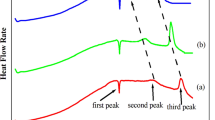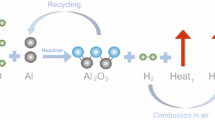Abstract
Mechanical activation is found to enhance the reactivity of copper powder with acetic acid. The milling-induced increase in the thermal effect of the reaction between Cu and acetic acid is shown to be associated with the activation of the molecular oxygen involved in the reaction. The activation is due to the presence of lattice oxygen with increased bond energies.
Similar content being viewed by others
REFERENCES
Morokhov, I.D., Petinov, V.I., Trusov, L.I., and Petrunin, V.F., Structure and Properties of Small Metallic Particles, Usp. Fiz. Nauk, 1981, vol. 133, no. 4, pp. 653–692.
Heinike, G., Tribochemistry, Berlin: Akademie, 1984. Translated under the title Tribokhimiya, Moscow: Mir, 1987.
Ivanov, G.V., Yavorovskii, N.A., Kotov, Yu. A., et al., Self-propagating Sintering of Ultrafine Metallic Powders, Dokl. Akad. Nauk SSSR, 1984, vol. 275, no. 4, pp. 873–875.
Poluboyarov, V.A., Andryushkova, O.V., Avvakumov, E.G., et al., Origin of Optical Absorption in the Diffuse Reflectance Spectra of Mechanically Activated Oxides, Sib. Khim. Zh., 1993, no. 1, pp. 119–125.
Poluboyarov, V.A., Andryushkova, O.V., Avvakumov, E.G., et al., Experimental Study of Processes Induced by Mechanical Activation of Oxides, Fiz.-Tekh. Probl. Razrabotki Poleznykh Iskopaemykh, 1993, no. 1, pp. 93–107.
Makarova, O.V., Yur’eva, T.M., Kustova, G.N., et al., Reaction of Hydrogen with Copper-Containing Oxide Catalysts: I. State of Copper Chromite and Its Activity for Acetone Hydrogenation to Isopropanol, Kinet. Katal., 1993, vol. 34, no. 4, p. 681.
Makarova, O.V., Yur’eva, T.M., Plyasova, L.M., et al., Reaction of Hydrogen with Copper-Containing Oxide Catalysts: II. Reactions of Hydrogen-Reduced Copper Chromite and Copper Zinc Oxide with Acetone and Carbon Monoxide, Kinet. Katal., 1994, vol. 35, no. 3, p. 406.
Sirotkina, E.E, Kobotaeva, N.S., and Svarovskaya, N.V., Reactivity of Copper Powders, Materialy V vserossiiskoi konferentsii po fizikokhimii ul’tradispersnykh sistem (Proc. V All-Russia Conf. on the Physical Chemistry of Ultrafine-Particle Systems), Yekaterinburg, 2000, p. 51.
Koch, C.C., The Synthesis and Structure of Nanocrystalline Materials Produced by Mechanical Attrition: A Review, Nanostruct. Mater., 1993, vol. 2, pp. 109–129.
Koch, C.C., Synthesis of Nanostructured Materials by Mechanical Milling: Problems and Opportunities, Nanostruct. Mater., 1997, vol. 9, pp. 13–22.
Oleszak, D. and Shingu, P.H., Nanocrystalline Metals Prepared by Low Energy Ball Milling, J. Appl. Phys., 1996, vol. 79, no. 6, pp. 2976–2980.
Avvakumov, E.G., Potkin, A.R., and Samarin, O.I., USSR Inventor’s Certificate no. 975068, Byull. Izobret., 1982, no. 43.
Karnaukhov, A.P., Adsorbtsiya. Tekstura dispersnykh i poristykh materialov (Adsorption and Texture of Fine-Particle and Porous Materials), Novosibirsk: Nauka, 1999.
Handbook of X-ray Photoelectron Spectroscopy, Wagner, C.D. et al., Eds., Eden Prairie: Perkin-Elmer, 1978.
Ripan, R. and Ceteanu, I., Chimia metalelor, Bucharest: Editura Didactica si Pedagogica, 1969. Translated under the title Neorganicheskaya khimiya, Moscow: Mir, 1972.
Cherepanov, A.N., Solonenko, O.P., Poluboyarov, V.A., et al., Application of Uitra-Fine Powders of Refractory Compounds for Improving the Mechanical Properties of Plasma-Sprayed Coating, Proc. XV Symp. on Plasma Chemistry, Orleans, 2001, vol. 6, pp. 2527–2531.
Poluboyarov, V.A., Lapin, A.E., Korotaeva, Z.A., et al., Effect of Mechanical Activation on the Strength of Plasma-Sprayed Metallic Coatings and Reactivity of Metallic Copper, Fiz. Mezomekh., 2002, vol. 5, no. 2, pp. 97–102.
Poluboyarov, V.A., Lapin, A.E., Korotayeva, Z.A., et al., The Effect of Mechanical Action on Strength Characteristics of Plasmochemical Metal Coatings and the Reactivity of Metal Copper, Int. Workshop Mesomechanics: Foundations and Applications, Tomsk, 2001, p. 56.
Poluboyarov, V.A., Lapin, A.E., Korotayeva, Z.A., et al., The Effect of Mechanical Action on the Reactivity of Metal Copper, Int. Conf. on the Fundamental Bases of Mechanochemical Technologies, Novosibirsk, 2001, p. 67.
Nechaeva, S.I., Chalykh, A.E., Toporov, Yu. P., and Yaroslavtseva, E.M., Phase Transformations of Polyamide Dispersed with Chromium Hexaaquachloride, Polym. Sci., Ser. A, 1994, vol. 36, no. 5, pp. 619–624.
Suryanarayana, C., Mechanical Alloying and Milling, Prog. Mater. Sci., 2001, vol. 46, pp. 1–184.
Vasil’ev, L.S. and Lomaeva, S.F., Mechanisms Limiting Size Reduction in Powders Produced by Mechanical Milling, Fiz. Met. Metalloved., 2002, vol. 93, no. 2, pp. 1–9.
Guan, R., Hashimoto, H., and Yoshida, T., Electron-Microscopic Study of the Structure of Metastable Oxides Formed in the Initial Stage of Copper Oxidation: I. Cu4O, Acta Crystallogr., Sect. B: Struct. Sci., 1984, vol. 40, pp. 109–114.
Guan, R., Hashimoto, H., and Kuo, K.H., Electron-Microscopic Study of the Structure of Metastable Oxides Formed in the Initial Stage of Copper Oxidation: II. Cu8O, Acta Crystallogr., Sect. B: Struct. Sci., 1984, vol. 40, pp. 560–566.
Guan, R., Hashimoto, H., Kuo, K.H., and Yoshida, T., Electron-Microscopic Study of the Structure of Metastable Oxides Formed in the Initial Stage of Copper Oxidation: IV. Cu4O-S1 and Cu4O-S2, Acta Crystallogr., Sect. B: Struct. Sci., 1987, vol. 34, pp. 343–346.
Sadykov, V.A, Structural Perfection and Microstructure of Oxidation Catalysts, Doctoral (Chem.) Dissertation, Novosibirsk, 1998.
Barr, T.L., Studies in Differential Charging, J. Vac. Sci. Technol. A, 1989, vol. 7, no. 3, pp. 1677–1683.
Bukhtiyarov, V.I., Prosvirin, I.P., and Kvon, R.I., Application of Differential Charging for Analysis of Electronic Properties of Supported Silver, J. Electron Spectrosc. Relat. Phenom., 1996, vol. 77, pp. 7–14.
Bukhtiyarov, V.I., Prosvirin, I.P., Tikhomirov, E.P., et al., In Situ Study of Selective Oxidation of Methanol to Formaldehyde over Copper, React. Kinet. Catal. Lett., 2003, vol. 79, no. 1, pp. 181–188.
Knop-Gericke, A., Hävecker, M., Shedel-Niedrig, Th., and Schlögl, R., Characterisation of Active Phases of a Copper Catalyst for Methanol Oxidation under Reaction Conditions: An In Situ X-ray Absorption Spectroscopy Study in the Soft Energy Range, Topics Catal., 2001, vol. 15, p. 27.
Author information
Authors and Affiliations
Additional information
Translated from Neorganicheskie Materialy, Vol. 41, No. 2, 2005, pp. 151–161.
Original Russian Text Copyright © 2005 by Poluboyarov, Lapin, Korotaeva, Prosvirin, Bukhtiyarov, Sirotkina, Kobotaeva.
Rights and permissions
About this article
Cite this article
Poluboyarov, V.A., Lapin, A.E., Korotaeva, Z.A. et al. Effect of mechanical activation on the reactivity of powder copper. Inorg Mater 41, 110–119 (2005). https://doi.org/10.1007/s10789-005-0029-9
Received:
Revised:
Issue Date:
DOI: https://doi.org/10.1007/s10789-005-0029-9




